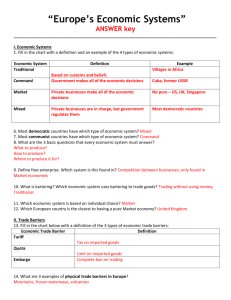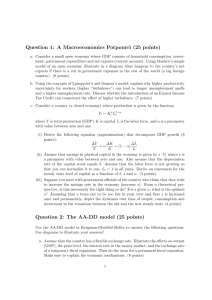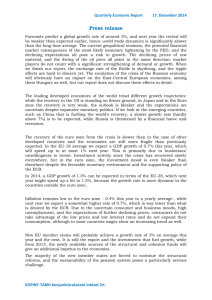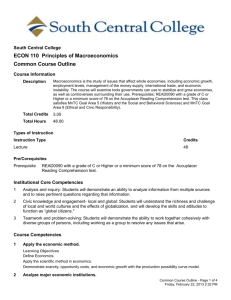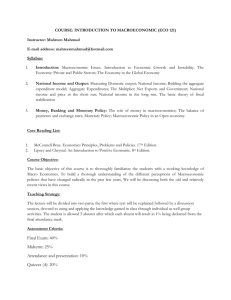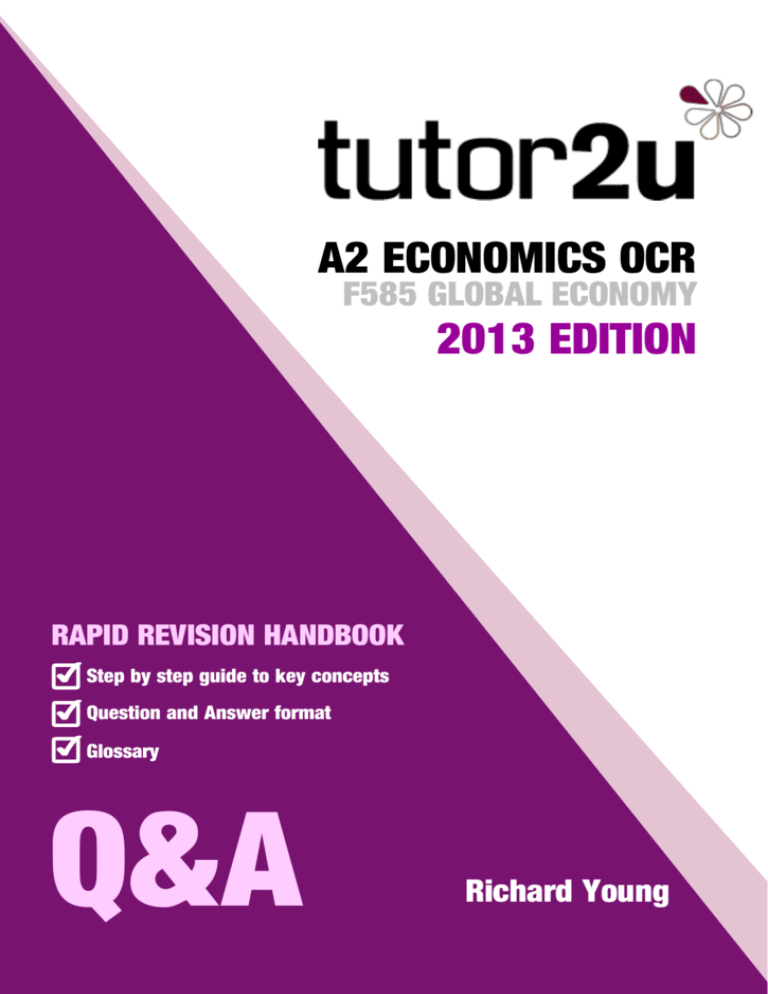
A2 ECONOMICS OCR
F585 GLOBAL ECONOMY
2013 EDITION
RAPID REVISION HANDBOOK
Step by step guide to key concepts
Question and Answer format
Glossary
Q&A
Richard Young
A2 The Global Economy
Contents
Keynesian and New Classical economics ..... 2
Exchange rate determination.................... 19
Economic performance ....................................... 3
Exchange rate systems................................. 21
Causes of economic growth ............................... 4
Purchasing Power Parity ............................ 22
Short Run Economic growth ........................ 4
J curves and Marshall-Lerner .................... 23
Economic cycle .................................................. 5
Balance of payments imbalances............. 24
The multiplier..................................................... 5
Integration ............................................................. 26
The accelerator .................................................. 6
Trading Blocs ................................................... 26
Long Run Economic Growth......................... 7
Economic integration ................................... 27
Consequences of economic growth................ 8
Trade creation and diversion.................... 28
Growth and unemployment ......................... 8
Impact of Monetary Union ......................... 29
Growth and Inflation ....................................... 9
Economic Shocks ............................................ 29
Growth and the Balance of Payments .... 10
Development and Sustainability................... 30
Growth and the Fiscal Position ................. 11
Economic growth and development ...... 30
Policy Issues........................................................... 12
Common and diverse features of
developing economies ................................. 31
Economic stability .......................................... 12
Fiscal policy issues ......................................... 12
Monetary policy issues ................................. 14
Supply side policy issues ............................. 16
International Competitiveness.................. 16
Trade and integration ........................................ 17
The effects of international trade............. 18
The terms of trade .......................................... 18
Pattern of global trade .................................. 19
Policies to promote development ........... 32
Sustainability ................................................... 34
The economics of globalisation ..................... 36
Globalisation .................................................... 36
Multinationals and FDI ................................ 37
International finance .................................... 38
International institutions ........................... 38
Glossary .................................................................. 40
Exchange rates ...................................................... 19
2013 Edition. First published 2010 © Richard Young.
All rights reserved. The right of Richard Young to be identified as the author of this Work has been
asserted in accordance with the Copyright, Designs and Patents Act 1988.
| Short Run Economic growth
1
Trade creation and diversion
What is trade creation? Trade creation occurs when economic integration results in high-cost
domestic producers being replaced by low-cost imports from efficient partner countries.
Use a diagram to illustrate trade creation.
S UK is the domestic supply of lamb; D UK is the
domestic demand for lamb; SF is the supply of
imported French lamb. A UK tariff makes price P1
with Q1 traded, of which Q1-Q2 is imported.
A customs union abolishes tariffs. Price falls to P2
with Q3 traded, of which Q3-Q4 is imported.
Consumer surplus rises by areas A + B + C + D.
However domestic output falls by Q2-Q4 with a
producer surplus loss = A. Lost tariff revenues to
govt = C so that the net welfare gain from trade
creation = areas B + C.
What is trade diversion? Trade diversion occurs when economic integration results in lowcost producers outside the union being replaced by high cost producers in partner countries.
Use a diagram to illustrate trade diversion.
Assume the UK is outside a customs union: S UK
is the domestic supply of lamb; S NZ represents
the supply of New Zealand lamb; and S F the
supply of French produced lamb.
A UK tariff on imports means price = P1 with Q1
traded with Q2 is supplied by domestic firms and
Q1-Q2 imported from the lowest cost producer,
New Zealand. No French lamb is imported
The UK now joins a European customs union. A
common external tariff remains for nonmembers (New Zealand) but is abolished for
members (France). Price falls to P2 and Q3 is demanded. Q4 is supplied domestically and Q3-Q4
is imported from France. There are no imports of New Zealand lamb
Trade diversion arises because low cost, non-member imports from New Zealand are replaced
by a less efficient member producer, France. French imports replace less efficient UK producers
but efficient New Zealand producers are replaced by less efficient French suppliers.
Welfare impacts are increased UK consumer surplus of A + B + C + D; reduced producer surplus
of A; Lost UK govt tax revenues of C+E. The net welfare gain = area B+D less area E. Overall
impact depends on the relative efficiency of customer union producers and non-members ie
area E and the price elasticity of demand and supply which affect the size of areas D and B
Justify economic integration. Cet par, economic integration results in both a trade creation
and trade diversion effects. The more inefficient members are, the bigger the trade diversion
effect. Integration only results in a net welfare increase if the trade creation effect is greater
than the trade diversion effect.
Identify the dynamic effects of integration. Domestic monopolists face increased competition
from firms in member countries who no longer face tariffs giving an incentive to improve
productive efficiency and undertake R&D and innovation resulting in dynamic efficiency gains.
Increased market size from supplying more countries means potential economies of scale for
domestic firms which reduce LAC FDI Countries outside the integration area (eg Japan) invest in
new plant in, say, the UK so that output can avoid common external tariffs
Identify the potential costs of integration. The process of integration may cause structural
change hence structural unemployment. Trade diversion can affect non-member countries eg
developing economies supplying commodities
28
Trade creation and diversion |
Impact of Monetary Union
What is monetary union? Monetary union (MU) is deep form of integration where member
countries give up their own currencies and adopt a single currency
Analyse the potential benefits to a country joining a monetary union area
Reduced transaction costs: economic agents now avoid bank charges on currency
exchanges in the MU area. Lower export costs increase X, hence AD and GDP rise.
Elimination of exchange rate: firms do not need to insure against exchange rate
movements. Less risk from a stable macro environment causes more investment, hence
AD and GDP increase
Increased competitive pressure encourages productive efficiency. Where firms invest in
successful R&D new processes lead to dynamic economies of scale reducing firms long
run unit cost. The increase in LRAS results in potential economic growth
What are the preconditions for successful monetary union? A single currency works best
when member country economies experience economic convergence ie different economies have
similar economic conditions eg similar rates of economic growth or unemployment
Define fiscal convergence. When different economies have similar fiscal conditions eg similar
government debt to GDP ratios or a similar budget deficit as a % of GDP figure
Define monetary convergence. When different economies have similar monetary conditions
eg similar rates of inflation or interest rates
Why is economic convergence important? A lack of convergence within MU economies
creates conflicting policy objectives eg member economies in recession need interest rate cuts
to stimulate AD while booming economies in the same MU need interest rate rises to reduce AD
How is domestic monetary policy affected by monetary union? Members of a monetary
union lose the ability to set their own domestic monetary or exchange rate policy – even if a lack
of convergence means economic conditions between member countries vary significantly
Economic Shocks
Define an economic shock. A shock is an unexpected economic event eg an unanticipated
world recession or an unforeseen increase in commodity prices
What is the impact of external economic shocks? Economic shocks cause unexpected
changes in AD and/or short run AS and often require a policy response from the govt.
Distinguish between demand and supply side economic shocks. Demand side shocks affect
a component of AD eg a world recession cuts a country’s net exports, lowering AD and GDP.
Supply side shocks such as rise in oil prices reduce a country’s SRAS causing cost push inflation.
Which countries are most exposed to external demand side economic shocks? Open
economies reliant on foreign investment or where net exports are a major component of AD.
How do economies adjust to economic shocks? New classical economists argue free markets
cause prices to adjust to restore macro equilibrium at potential GDP. Keynesian economists
argue that reflationary demand management is needed to restore equilibrium at potential GDP.
Distinguish between asymmetric and symmetric economic shocks? An asymmetric shock
has differing effects on regions. A symmetric shock has an identical impact on regions
How can economies in monetary union adjust to asymmetric economic shocks? A fall in
relative wages and prices fall restores price competitiveness
Define contagion. The transmission of an economic shock in one economy to linked economies
Explain fiscal transfers. Fiscal transfers occur when taxes raised in one country or region are
made available to finance government spending in another country or region. Fiscal transfers
help economies adjust to asymmetric shocks.
| Impact of Monetary Union
29
Development and Sustainability
Economic growth and development
What is economic growth? Short run actual economic growth is a rise in a country’s real GDP.
Long run potential economic growth requires an increase in an economy’s productive capacity.
What is economic wellbeing? Economic wellbeing is an individual's material standard of living
and can be measured by real per capita GDP
What is development? Development occurs when individual’s economic wellbeing and quality
of life rise across all sections of an economy
Explain the term quality of life. Quality of life is the non-material aspect of welfare such as
health, education, life expectancy, social choice, self-esteem and freedom from fear
How is quality of life measured? Economists use development indicators eg the HDI
What is the Human Development Index (HDI) The HDI measures a country’s average
attainment in three aspects of development: life expectancy, education and real per capita GDP
What are the limitations of the HDI? Measuring development involves measuring indicators
for each chosen aspect of development. The UN’s HDI is an improvement on using GDP per
capita data, as it includes educational and life expectancy. However, other elements of nonmaterial welfare are overlooked eg gender equality, sustainability and freedom from fear.
Are economic growth and economic development the same terms? Economic growth is a
rise in material welfare: real GDP is rising. Development occurs when an individual’s economic
wellbeing and quality of life rise across an economy
List Todaro’s development indicators. For Todaro development requires
producing more ‘life sustaining’ necessities such as food shelter and health care and
broadening their distribution
Raising standards of living and individual self esteem
Expanding economic and social choice and reducing fear
Explain absolute poverty. People live in absolute poverty when their income is insufficient to
enjoy a minimum standard of living. Economic growth that raises income can cut poverty levels.
What is relative poverty? The OECD defines relative poverty as households receiving less than
60% of the median average income. The relatively poor do not have access to the range of goods
and service consumed by ‘average’ citizens resulting in social exclusion
Can GDP measure development? GDP only considers material wellbeing and overlooks
Quality of life factors such as life expectancy and knowledge
Sustainability issues eg depletion of non-renewable resources and the long term impact
of negative externalities such as C02 pollution on the environment
How can growth help development? Higher GDP creates employment and raises per capital
GDP, a component of the HDI. Higher incomes reduces absolute poverty and means more people
can afford basic life-sustaining products which leads to development. Economic growth means
higher income tax, expenditure tax and corporation tax receipts which can finance better public
services which improve education standards, life expectancy and other development indicators
How can growth threaten development? Economic growth may be inflationary or unevenly
distributed eg due to lack of a progressive tax system. States may not use higher tax revenues to
fund the improvements in education, health and social welfare needed for development
Does growth always result in development? Economic growth increases national income but
if incomes are unequally distributed then some groups may see little or no increase in their
individual incomes. If economic growth is achieved through capital intensive production
GDP rises have little impact on employment hence incomes and standards of living.
30
Economic growth and development |
Fiscal policy: government spending and
taxation decisions
Globalisation: the process of creating ever
closer links between national economies
Fiscal position: the balance between
government expenditure and tax receipts in
a given time period eg one year
Golden rule: over the duration of one
economic cycle government borrowing
finances investment and not current
expenditure
Fiscal rules: numerical targets for
government budgets or debt levels
Fiscal stance: the intended impact of
government spending and taxation plans on
the level of future economic activity
Fiscal transfers: taxes raised in one
country or region are made available to
finance government spending in another
country or region
Fixed exchange rate : the price of one
currency against other currencies is held
constant by state intervention
Flexibility: government can adjust fiscal
and monetary policy in response to an
economic shock without losing credibility
Floating exchange rate: The value of the
currency is determined in markets called
Foreign Exchange Market (Forex), without
any government intervention
Forecast: a statement of what is expected
to happen in the future
Foreign currency reserves: official
international reserves (deposits) of
overseas currencies of $, €, ¥ etc held by the
government at the central bank
Foreign direct investment (FDI): a
multinational in one economy acquires a
lasting interest in a business in another
economy; international investment
Foreign Exchange Market (FOREX): the
place where currencies are traded
Free trade area: an agreement between
two or more countries to abolish tariffs in
the new bloc
Futures: a forward contract where
economic agents agree to buy or sell
commodities or currencies at a fixed price
at a future date
GDP deflator: an index measuring the
prices of goods and services purchased by
households, firms and the government
Gilts: government issued bonds paying
interest. Also called government securities
| International institutions
Government: the body that passes,
monitors and enforces laws, collects taxes
to finance public expenditure, and
intervenes in markets to influence the
behaviour of economic agents
Gross Domestic Product (GDP): the total
value of goods and services produced in an
economy in a time period
Gross National Income: the total income
earned by the citizens of a country in one
year from economic activity, during a given
period, usually one year
Gross National Product: measures
economic activity a nation’s citizens where
ever they are in the world
Growth maximisation: the firm's objective
to increase its size
Heckscher–Ohlin theory: a capitalabundant country will export the capitalintensive good; labour-abundant country
will export the labour-intensive good
Hedging: techniques that aim to reduce
financial risk and uncertainty from
unexpected changes in the price of
commodities or currencies
High human development: countries with
a HDI of 0.8 or higher
High-income economy: a World Bank
classification of a country with a 2009 per
capita Gross National Income of $12,196 or
more
Human capital: the skill knowledge and
expertise of the labour force acquired
through experience education and training
Human Development Index (HDI): a
measure of a country’s average
achievements in three equally weighted
aspects of human development: life
expectancy, educational attainment and per
capita $PPP income
Import substitution: domestically made
products replace imports
43
Index of Sustainable Economic Welfare :
a measure of output that adjusts GDP to
take account of activities that raise or
reduce well being
Industrialisation: an increase in the
proportion of GDP and employment
accounted for by the secondary sector of the
economy ie manufacturing
Infant industry: industries with a potential
comparative advantage that need short run
protection from lower cost overseas rivals
while they establish themselves
Infant Industry Argument: economic
development requires infant industries in
developing countries receive protection
from rivals developed countries to allow
them time to realise their potential
competitive advantage
Inflation targeting: a monetary policy
strategy where interest rate changes and
other monetary tools are used to try to keep
the inflation rate within a band and so
maintain price stability
Inflationary pressure: upward forces on
the price level from cost push or demand
pull inflation factors - Firms may opt to hold
or raise prices to maintain margins
Integration: when economic activity in
separate regions or countries become
increasingly interlinked and interdependent
eg the European Union
Interdependent: when economic agents
are interlinked eg trading partners become
mutually dependent on one another for
products
Interest rate differentials: a gap in
interest rates
Inter-industry trade: the exchange of
products made by different industries
Intermediate output: items sold to firms
and used to make products eg components
and raw materials
International competitiveness: the ability
of firms in an economy to match the price
and quality of other nation’s output
International finance: capital flows across
national borders
International Labour Organisation: a UN
agency that that set international standards
44
International institutions |
for labour eg methods for calculating
unemployment figures
International Monetary Fund (IMF) : the
central institution of the international
monetary system established to promote
international financial stability.
Inter-regional trade: the exchange of
products between nations in different
geographical areas
Intra-industry trade : the exchange of
products made by the same industry
Intra-regional trade: the exchange of
products between nations in the same
geographical area
Inverted J curve effect: the current
account initially improves following an
appreciation of a currency where the trade
balance initially improves before it worsens
J Curve effect: the path followed by the
current account following an exchange rate
depreciation where the trade balance
initially worsens before it improves
Knowledge and technology transfer: the
transfer of research and development
outcomes between firms and countries
Laffer curve: a graph showing the
relationship between tax rates and tax
revenues
Laissez faire: a view opposing state
intervention in free markets beyond
protecting property rights and ensuring law
and order
Legitimacy: wide spread support from
economic agents for government
macroeconomic objectives and policies
Long term capital flows: flows of money
between countries to finance foreign direct
investment in assets such as land, buildings,
stocks and portfolio investment in eg shares
Long term unemployment: the number of
workers who have been without a job for
more than one year
Low human development: countries with
a HDI below 0.5
Low-income economy: a World Bank
classification of a country with a 2009 per
capita Gross National Income of $995 or
less

